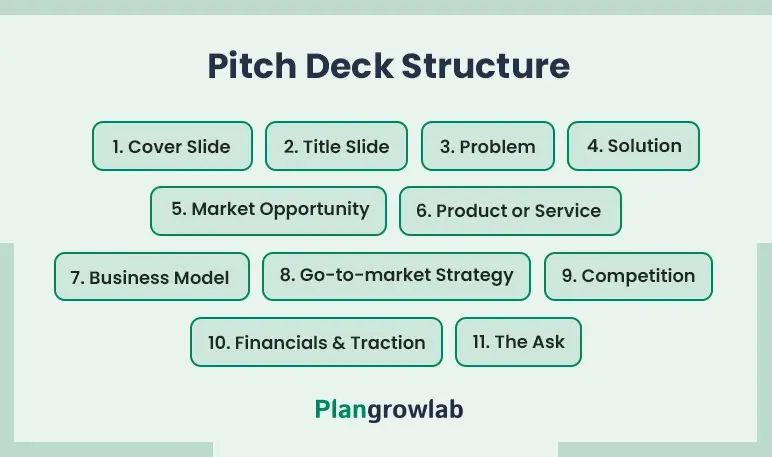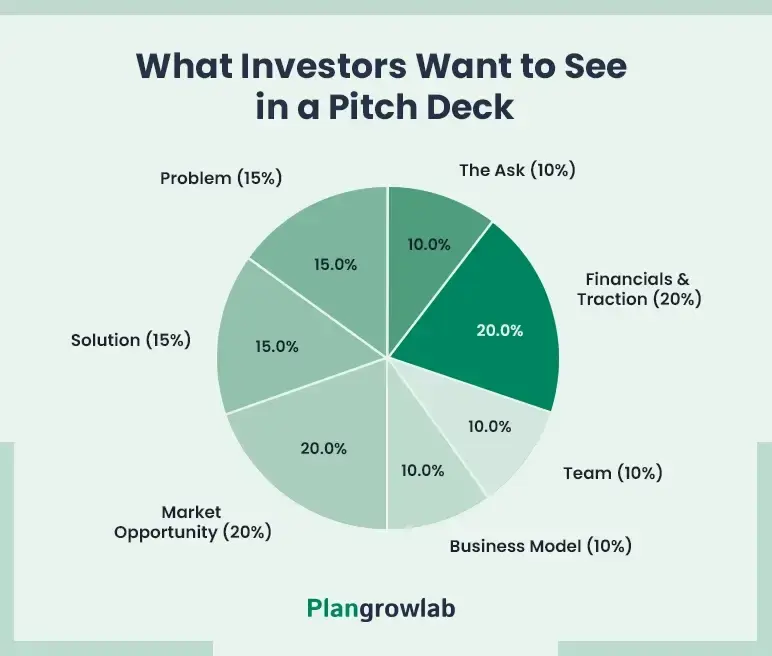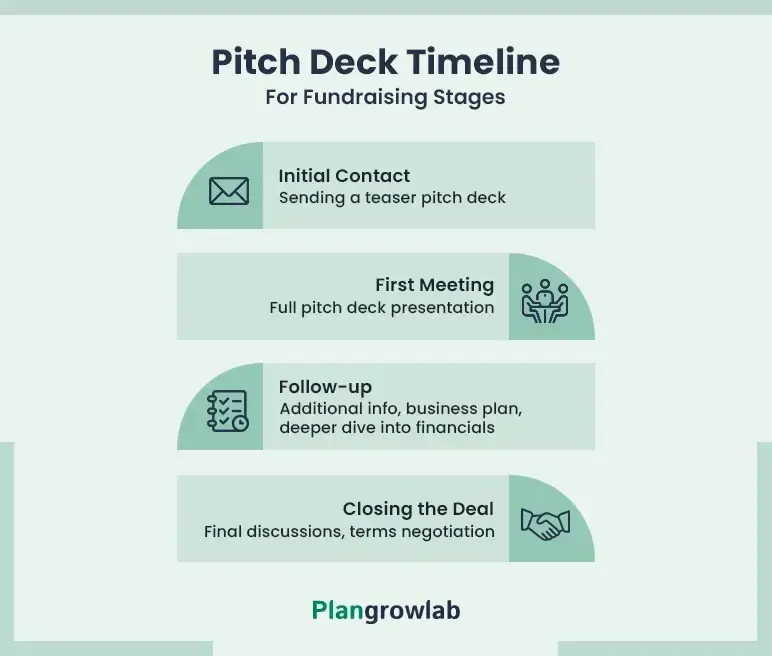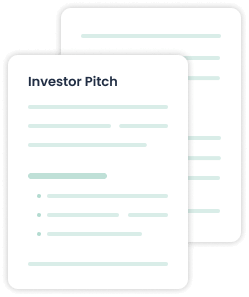I once built a 40-slide pitch deck. Guess how many slides the investors cared about? Maybe six.
And that's being generous.🥲
If you think your job is to impress investors with everything your business has ever done, bad news: You’re already losing them.
You might be asking, “What is a pitch deck exactly?” It’s a short presentation that highlights your business idea and value proposition. I had to learn (the hard way) that a good pitch deck is simple. It tees up one thing: a real conversation.
After hours of adding “important” stuff nobody asked for, I figured out a better way. I’ll show you exactly what to put in and what to leave out so you don’t end up ghosted like I was.
What is a pitch deck?
According to the pitch deck definition, a pitch deck is a visual, concise presentation that highlights the core aspects of your business—the problem, solution, market, and your unique value proposition. Typically, in 10–15 slides. It's designed to grab attention and spark interest in your business, not dive into every detail.
Investors expect your deck to give a quick overview, so it should clearly outline the business opportunity, highlight your core team members, and show you know the market trends better than they do. Bad pitch decks drown in buzzwords. Great presentations tell a clear story, leaving the audience thinking, “Okay, this founder gets it.”
Is a pitch deck & business plan presentation the same?
Yes, a business plan presentation and a pitch deck are the same thing. Both refer to a slide-based summary of your business plan, designed to explain what your business does, how it makes money, and what you're asking for (usually funding or support).
That said, a business plan presentation can sometimes go deeper than a typical pitch deck. If you're sharing it with a bank, internal team, or detailed partner review, it might include more financial details, operational plans, or timelines.
But when someone refers to either in the context of a live pitch or Zoom call, they’re usually talking about the same thing: a clear, slide-based summary of your business idea.
What is the purpose of a pitch deck?
A pitch deck presentation has only one clear intention: to place your business idea in front of potential investors and make them wish to hear more. It's your initial serious opportunity to demonstrate how your company's mission aligns with where the opportunity is, who the target market is, and how you will develop genuine growth.
You’ll use a pitch deck to:
- Set up investor meetings by sending a brief presentation covering your traction slide, market opportunity, team slide, and value proposition.
- Introduce your startup at demo days and pitch competitions with sharp visual elements and clear messaging.
- Reach out to strategic partners who need to understand your market size and early progress.
- Onboard early hires by showing the company's structure, goals, and growth plans.
The deck outlines key facts from different angles, allowing investors or partners to quickly judge whether your business fits their investment thesis or collaboration goals.
But when you only have a few minutes of attention from potential investors, every slide in your pitch deck has to earn its spot. That starts with knowing exactly what investors expect to see.
What to include in your pitch deck presentation?
The structure of your pitch deck matters as much as the story you’re telling.
These are the must-have slides if you want your presentation to work. Each slide plays a specific role in answering investors’ key questions about your business.

Cover slide (company name and tagline)
The cover slide introduces your company with a clear tagline and an appealing visual. Its primary goal is to set the deck's tone and immediately grab attention. Keep it simple.
This isn’t where you drop vague slogans like “Changing the World.” Instead, explain in plain language what your company does.
For example, Airbnb’s early tagline, “Book rooms with locals rather than hotels,” told you exactly what the platform offered without any buzzwords.
1. Title slide (vision and value proposition)
Your title slide goes one layer deeper than the cover. It should introduce the vision behind your company—the future you’re trying to build—and summarize your value proposition today.
The vision should be ambitious but believable. Investors want to see that you’re thinking big but also grounded. The value proposition, on the other hand, must be short, clear, and specific.
At a glance, the audience should know what problem you solve and why your solution differs from others in the market.
2. Problem slide
The problem statement slide is one of the most important parts of a pitch deck. Nothing else matters if you don’t clearly show that a real, painful problem exists.
Here, you have to define the problem your target market faces today. Explain who experiences it, how widespread it is, and why current solutions are insufficient.
Use facts, short examples, or brief data points to back it up. The stronger and more relatable the problem feels, the more urgent your entire pitch will seem. Avoid being vague, as investors need to instantly recognize that the problem is real, serious, and worth solving.
3. Solution slide
After making the problem feel real, you must immediately show how you solve it. The solution slide should introduce your product or service and explain, in simple terms, how it fixes the problem you just described.
Focus on benefits, not technical features. Explain clearly why your approach works better than current alternatives.
If possible, include a product screenshot, a demo image, or a quick product mockup, something visual that helps the audience understand immediately.
At this point, you’re not diving into every detail of your offering. You’re showing you have a real, workable answer to a real and painful problem.
4. Market opportunity (target market and market size)
Even the best ideas won’t go far if there isn’t a large enough market behind them. This slide should define exactly who your target audience is and how big the opportunity is.
Be specific about it. Identify clear customer segments with real demographic or behavioral traits. Then, present the market size: ideally, the total addressable market (TAM), the serviceable available market (SAM), and your initial serviceable obtainable market (SOM).
Use real, sourced numbers wherever possible. Investors expect to see enough market potential to build a big business.
5. Product or service (how it works)
After describing the solution at a high level, you must show it’s real and works. The product or service slide should give a quick walkthrough of your solution’s functions without overwhelming the audience with technical jargon.
Focus on the user experience and the unique features that make your solution effective. You can use screenshots, simple diagrams, or short visual examples to make it easy to understand.
Investors may not be technical experts in your field, so clarity is more important than complexity. By the end of this slide, the audience should believe that your product exists and does exactly what you claim it can do.
6. Business model
The business model slide explains how you plan to make money and why the model makes sense for the problem you’re solving. Describe who your customers are, what they pay for, and how the money flows in.
Be specific: Are you using a subscription model, a direct sales model, taking commissions, or relying on advertising? If you already have early revenue or signed agreements, highlight them here as proof that your business model works.
This slide shows that the business can sustain itself financially in real practice as the company grows.
7. Go-to-market strategy
Even the best product can’t succeed if no one knows about it. Your go-to-market strategy slide needs to make it abundantly clear how you intend to reach your target market and begin generating traction.
Describe the channels you will use, like social media, SEO, alliances, direct selling, or mailings.
If you have a phased strategy, such as beginning with a small customer segment and growing later, state it. Investors want to see that you’ve considered customer acquisition costs, scaling strategies, and real-world execution.
This slide proves that you understand that distribution is just as important as product development.
8. Competition and competitive advantage
Use this slide to map out your direct competitors, what alternatives people currently use, and where you fit into the picture. A simple comparison table or quadrant chart can help quickly position your company against others.
Above all, thoroughly describe your competitive edge—how your solution is superior, sooner, cheaper, or more difficult to imitate.
Whether it's novel technology, a superior business model, a network effect, or more powerful branding, make it clear why you will triumph in the long run. Avoid claiming you have no competition. It shows either a lack of research or a non-existent market.
9. Team slide
This slide is where you prove that you have the right people to make this business succeed. Introduce the founding team and any key hires, with short highlights of their most relevant experience.
Focus on showing why these individuals are uniquely qualified to solve this problem and build this company. If any team members have notable exits, major industry experience, or technical expertise, mention it. You can also include important advisors or board members if they add credibility.
This slide is about showing that the team has the right mix of skills, experience, and determination to execute.
10. Financials and traction
This slide shows where you’re today and where you’re going, so provide a clear financial projection covering the next three to five years, focusing on revenue, expenses, and expected growth.
Charts should be clean and easy to understand at a glance. Alongside projections, show real traction if you have it—user growth rates, pilot customers, revenue milestones, partnerships, and product launches.
If you don’t have much revenue yet, focus on other progress that validates market interest. Investors who review your financials want to understand the opportunity at a glance. Clarity will get you further than overwhelming them with a wall of numbers.
11. The ask (Funding needs and use of funds)
Finally, you must clearly state what you’re asking for. Spell out exactly how much funding you seek, and briefly explain how you plan to use the money.
Break it into major categories—product development, marketing, hiring, or operations. Being specific shows, you have a real plan and understand your priorities.
If you’re not raising money but are pitching for a partnership, competition win, or some other opportunity, tailor your ask accordingly.
Always end this slide with your contact information so interested parties can easily follow up.
There you have it—key elements of a pitch deck!

There’s no single standard for pitch decks. Successful startups adjust the type of deck they use based on who they’re talking to—potential investors, strategic partners, or even early potential clients.
Types of pitch decks
You wouldn't wear a tuxedo to the gym, would you? You shouldn't use the same pitch deck for every situation, either. Different scenarios need different types of decks.
As a startup founder, you need to be ready for different scenarios, and that means having different types of pitch decks. Here’s a breakdown:
Elevator pitch deck
An elevator pitch deck is built for speed. It’s a three-to-five-slide version that cuts straight to the essentials: what you’re building, who it’s for, and why it’s important.
You might use this when meeting a potential investor in a casual setting or sending a teaser deck via email. Every slide must be sharp, clear, and focused because you have about one to two minutes to spark real interest.
There’s no room for heavy details here—just a tight summary of the problem, your solution, a hint of traction, and a reason for someone to say, "Tell me more."
Demo day or competition pitch deck
Demo day pitch decks are designed for live pitching when you have a short time limit and a big audience. Think three to five minutes max; you often don’t get a second chance to explain if people zone out.
This type of deck focuses on a clear and compelling narrative rather than packing the slides with information. Founders use bold headlines, simple supporting visuals, and a strong narrative that ties everything together.
Since competitions move fast and often involve judges looking at multiple startups back-to-back, your deck needs to be direct enough to make an impact and memorable enough to stay top-of-mind when the event ends.
Dropbox’s original pitch at Y Combinator is a great example of how a simple story can stick with investors.
Investor pitch deck (Standard full deck)
The full investor pitch deck serves as your main tool when you’re raising serious funding. Typically, it runs between 10 and 20 slides and is used during meetings or sent to potential investors who want more than just a teaser.
This version covers all the important topics: solution overview, traction slide highlights, go-to-market strategy, team introductions, and expected growth path.
If you’re emailing the deck, you might include more text or speaker notes so the reader isn’t confused. In a live meeting, you keep the slides focused and expand verbally.
Either way, this deck should make it easy for investors to understand the strength of your startup and why you deserve their attention.
Sales deck and partner deck
You might hear about other versions, like sales decks or partner decks. These aren’t used to raise venture capital but to secure new customers or strategic partnerships.
A sales pitch deck focuses on how your product solves a client’s needs, often emphasizing distribution channels, pricing options, and use cases.
A partner deck highlights why collaboration makes sense, what each side brings to the table, and how growth benefits both parties. While the structure looks similar to a regular pitch, the audience’s priorities vary, so the messaging shifts accordingly.
The structure and style of your pitch deck should vary depending on whether you’re meeting a potential investor at a networking event, pitching on a demo day stage, or sending a cold email to a VC.
How should you create a pitch deck (best options)
When it’s time to assemble your pitch deck, you’ve two options. You can bring in a professional to build it, or roll up your sleeves and use an AI pitch deck builder to create it yourself.

Both approaches can work. You just have to pick what fits your goals, timeline, and, of course, budget.
Option 1: Hire a pro pitch deck consultant
Hiring a professional pitch deck consultant means getting real expertise on your side. It’s someone who has worked on dozens of pitch deck examples across different industries and knows exactly how to shape a story investors want to hear.
A good consultant understands how to structure the flow, highlight every important slide, and keep the audience’s attention focused.
You also get the advantage of professional design and the right use of modern design tools. Your slides look clean, sharp, and serious, which helps when you need to make a strong first impression.
Of course, quality comes at a price.
Hiring a seasoned consultant involves money, and it’s usually best for founders planning to secure funding through significant investment rounds.
You can’t afford to send out a rough draft when you have real meetings lined up. This option suits startup founders who already have a clear story and strong early traction and know they need a deck that feels ready for real money conversations.
Option 2: Consider an AI pitch deck builder
If you’re working with a tight budget, an AI pitch deck builder can be a practical choice.
Modern tools help you build a structured pitch deck template, suggest bullet points for each section, and organize your story in a way that makes sense to a new reader. It’s much faster and more affordable than hiring a professional.
You can get a complete deck in hours instead of weeks and won’t have to spend thousands upfront.
But there’s a catch. The final quality depends heavily on you.
AI tools can help get you started, but you'll still need to fine-tune the slides, sharpen the messaging, and ensure the deck speaks to your audience. Make sure each slide focuses on what's most important to keep your audience engaged.
This option works best for early-stage founders, solo entrepreneurs, or anyone needing a strong starting point without committing big resources right away.
Before you walk into the room (or hit “Send”), it’s not just about having the deck ready. It’s also about how you present it to investors because even the best deck won’t land if the delivery falls flat.
How much does it cost to make a pitch deck?
The cost depends on how you create it. Hiring a professional consultant can range from $2,000 to $10,000+, depending on the consultant’s experience and the complexity of your story.
You’re paying for deep industry knowledge, advanced use of design tools, and a final product with professional design that’s ready for serious funding rounds.
On the other hand, using an AI pitch deck builder costs much less, often between $20 and $100, depending on the tool you choose. Some platforms offer free basic versions, while premium options give you better templates and customization.
Each method comes with trade-offs. If you want a full cost breakdown (plus the pros and cons for each method), check out our complete guide to pitch deck costs.
Resources to help you build an awesome pitch deck
Everyone talks about "making a great pitch deck," but nobody tells you where to start.
Good news: We’ve already done the digging for you.
Best AI pitch deck generators
If you’re looking for speed, structure, and cost-efficiency, using an AI tool can be a smart way to build your first draft. Check out our listicle on best AI pitch deck generators to find the best tool for your requirements.
Real-life pitch deck examples
A strong pitch starts with knowing what works. Reviewing real-world pitch deck examples can give you a clear sense of how to structure your message and grab the audience's attention right away. See our real-life pitch deck examples breakdown for practical ideas.
Pitch deck creation guide
Knowing what a pitch deck needs and where it is makes the whole process easier. Our pitch deck creation guide explains each important slide clearly and shows how to use bullet points and design tools to keep your deck sharp and focused.
The bottom line
If there’s one thing you should take from all this, it’s that building a strong pitch deck is about being smart with what you show and just as smart with what you leave out.
The best decks get people nodding along and help you secure funding before you even reach the fifth slide.
Whether you’re starting from a pitch deck template, sketching out your first draft, or working with a consultant who knows how to keep a story sharp, the goal stays the same: Build a clear, focused pitch around what matters to your target audience.
And if you’re looking for real help? The team at Plangrowlab knows exactly how to craft an ideal pitch deck that grabs attention and holds it.
A strong pitch doesn’t guarantee funding. But it gives you the one thing you can’t pitch without: a real chance to shift your status quo.
Frequently Asked Questions
How is a pitch deck different from a business plan?
A pitch deck is a concise, graphical overview (10-15 slides) of key points of your company. A business plan is longer and includes your entire strategy and finances. Use the deck to grab attention; the business plan comes later.
How many slides should my pitch deck have?
Shoot for 10-15 slides. Prioritize the basics—problem, solution, market, team, and financials. Be brief, concise, and interesting. If it's more than 20 slides, trim down. If it’s over 20 slides, cut back.
Should I include financial projections even if my startup is very new?
Yes, even early-stage startups should include basic financial projections. Show investors you’ve thought about growth, even if it's just estimates. Focus on user growth or early traction if you don’t have much revenue yet.
Can I use a template for my pitch deck, or is it better to design from scratch?
Templates are great! They help keep your deck organized and save time. Just make sure to customize it to fit your brand and story. The design doesn’t need to be perfect; focus on content.
Is a pitch deck only useful for raising investment?
Not just for investment! A pitch deck can help pitch to partners, customers, and even potential hires. It’s a quick way to show your business value and vision.
What’s the biggest mistake founders make with pitch decks?
The biggest mistake is overloading the slides with too much info. Keep it simple and focus on the key points. Your deck should grab attention and leave investors wanting more.
How do I keep my audience’s attention during a pitch presentation?
Keep it brief. Prioritize interesting slides and a compelling story. Don't read off the slides. Make each slide meaningful, and don't waste your audience's time.
Can I send my pitch deck without presenting it live?
Yes! You can email your pitch deck as an intro. Just make sure it’s clear and self-explanatory. If needed, add speaker notes or context to clarify your message.
Is a pitch deck a visual slide presentation?
Yes, a pitch deck is a visual slide presentation that highlights key aspects of your business. It’s designed to grab investors’ attention and spark interest, typically covering the problem, solution, market opportunity, and financials.


